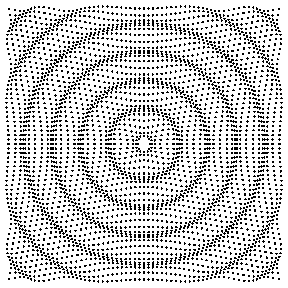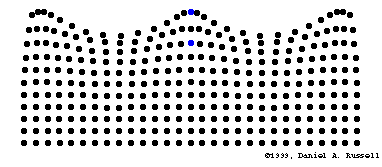Wavelength-distance from a point on a wave to the same corresponding point on the nest wave.
Frequency-number of waves that pass a point in one second.
(expressed in Hertz[Hz])
Wavelength has an inverse relationship to wave frequency
A crest is the highest point of a wave.
A trough is the lowest point of a wave.
Thursday, January 22, 2009
Types of Waves
Longitudinal
.Vibrates parallel to (in the same direction of) wave travel
-sound waves
.the other end of the medium without the actual movement of matter
-sound waves
.the other end of the medium without the actual movement of matter
Transverse
.Vibrates perpendicular (at right angles) to the wave travel
-electromagnetic waves
-electromagnetic waves
Water Waves
.A combination of longitudinal+transverse
Source:Photobucket(PhysOrg)
Waves and Sound
The Nature of Waves
 A wave is a rhythmic disurbance that transfers energy
A wave is a rhythmic disurbance that transfers energy-All waves are made by something that vibrates.
Mechanical waves need a matter medium to travel through.
(sound,water,seismic)
Two basic types of waves
a)Transverse
b)Compressional (longitudinal)
Amplitude- Size related to the energy carried by the wave (height)
Monday, January 12, 2009
Vocabulary Sections 5.1,5.2,5.4
Vocabulary
5.1/5.2/5.4
Energy-the ability to cause change.Kinetic Energy-energy in the form of motion.
Potential Energy-stored energy.
Work-the transfer of energy through motion
Mechanical Energy-the total amountof kinetic and potential energy in a system.
Law of Conservation of Energy-energy can neither be created nor destroyed.
Temperature-the measure of the average kinetic energy of the particles in a sample of matter.
Thermal Energy-the total energy of the particles that make up a material.
Heat-the thermal energy that flows from something with a higher temperature to something with a lower temperature.
Specific Heat-the amount of heat required to raise the temperature of 1kg of a material by one degree.
How to Calculate Changes in Thermal Energy
Q=m x (delta)T x Cp
Q=change in thermal energy
m=mass
(delta)T=change in temperature (Tf-Ti)
Cp=specific heat of substance
Example:
32 gram silver spoon
60(degrees)C to 20(degrees)C
Q=m x (delta)T x Cp
Q=.032 x -40(degress)C x 235j/kg.k
Q=-300.8
Measure Thermal Energy
Different materials need different amounts of heat to produce similar changes in their temperatures. The materials have different specific heats.
Land heats up and cools down faster than water.
Specific Heat is the amount of heat required to raise the temperature of 1 kg of a material by one degree (C or K)
1)Cp water=4184J/kgC
2)Cp sand=664J/kgC
Land heats up and cools down faster than water.
Specific Heat is the amount of heat required to raise the temperature of 1 kg of a material by one degree (C or K)
1)Cp water=4184J/kgC
2)Cp sand=664J/kgC
Thursday, January 8, 2009
Temperature+Thermal Energy
TEMPERATURE
Temperature-the measure of the average kinetic energy of the particles in a sample of matter.
THERMAL ENERGY
.Thermal Energy is the total energy of the particles that make up a material.
.Different kinds of matter have different thermal energies, even when mass and temperature are the same.
.Also known as Internal Energy
Law of Conservation of Energy
Law of Conservation of Energy
.Law of Conservation of Energy-energy can neither be created nor destroyed
.Energy is always changing from one kind to another.
.The total energy of an object never changes.
Kinetic&Potential Energy
KINETIC ENERGY
.Kinetic Energy exists whenever an object which has mass is in motion with some velocity..Everything you see moving about has kinetic energy.
.The greater the mass or velocity of a moving object, the more kinetic energy it has.
POTENTIAL ENERGY
.Potential energy exists whenever an object which has mass has a position within a force field.
.Potential energy is stored energy.
.The amount og Potential Energy depends on the sample's postion or condition.
Energy and Work
Energy and Work
WORK
.Work is the transfer of energy through motion.
.In order for work to take place, a force must be exerted through a distance.
.The amount of work done depends on two things:
---The amount of force exerted.
---The distance over which the force is applied.
-Two factors to decide that work has been done:
...something has to move.
...the motion must be in the direction of the applied force
-Work can be calculated by the this formula.
***Work=force x distance***
ENERGY
.Energy is defined as the ability to cause change
.Energy exists in forms including:
-radiant
-chemical
-thermal
-nuclear
Subscribe to:
Posts (Atom)






